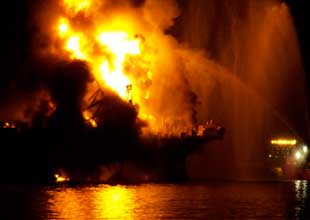
Photo courtsey US Coast Guard.
Halliburton, the oil field services giant that provided the cement for BP’s Macondo well, knew months before the explosion and spill that the cement mixture used on the well was not stable, according to new findings the National Oil Spill Commission released Thursday. Despite multiple failed tests on the mixture, Halliburton and BP used the cement on the well.
In the months since the spill, it’s become clear that something went wrong with the cement job on the Macondo well, which should have prevented oil and gas from entering the well and causing the April 20 explosion. BP used a nitrogen foam cement that Halliburton recommended and supplied on the well. In a letter to the commission, the panel’s lead investigator, Fred H. Bartlit Jr., cites documents obtained from Halliburton and tests conducted by cement experts at Chevron that suggest that there were plenty of warnings about this cement mixture before the explosion.
The documents from Halliburton show that the company conducted two tests on the cement mixture in February 2010, and both indicated that it was not stable. The company provided the results of one of those two tests to BP in March, but Bartlit states that “There is no indication that Halliburton highlighted to BP the significance of the foam stability data or that BP personnel raised any questions about it.”
It appears that a third test conducted on April 13, seven days before the explosion, again demonstrated that the mix was unstable, but Halliburton did not provide that data to BP. Only a fourth test, performed after Halliburton’s lab modified the testing procedure, produced results that found the mixture to be stable—but that data was not available until after the explosion, which indicates that the mixture was used with no lab results that suggested it would be stable.
Further, the letter includes data from testing that Chevron conducted on a indentical mixture for the spill commission, released on October 26, which also found that the slurry was not stable:
Chevron’s report states, among other things, that its lab personnel were unable to generate stable foam cement in the laboratory using the materials provided by Halliburton and available design information regarding the slurry used at the Macondo well. Although laboratory foam stability tests cannot replicate field conditions perfectly, these data strongly suggest that the foam cement used at Macondo was unstable. This may have contributed to the blowout.
The report concludes that while there are tests designed to ensure that a cement job is stable and methods to remedy it if they are found to be faulty, “BP and/or Transocean personnel misinterpreted or chose not to conduct such tests at the Macondo well.”












